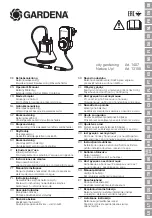
18
t2. Up and down arrow buttons are used to change the t1 and
t2 default values and OK confirms each setting.
DAR and PI insulation test voltages are selected on the central
rotary switch by simply aligning the switch opposite to the
required insulation test voltage. Press and hold TEST to start a
DAR/PI test.
DAR is defined as the ratio of insulation resistance at 1 minute
divided by insulation resistance at 30 seconds, although a 1
minute, 15 second DAR is also popular:
DAR = IR
60s
/ IR
30s
Insulation Condition
DAR result
Poor
< 1
Acceptable
1 – 1.4
Excellent
1.4 – 1.6
IEEE standard 43-2000, Recommended Practice for Testing
Insulation Resistance for Rotating Machines, defines PI as the
ratio of insulation resistance at 10 minutes divided by
insulation resistance at 1 minute:
PI = IR
10min
/ IR
1min
If IR
1min
> 5000 M
Ω
the PI may or
may
not be an indication of
insulation condition and is therefore not recommended by
IEEE std. 43.
Insulation Condition
PI result
Poor
< 1
Questionable
1 - 2
Acceptable
2 - 4
Good
> 4
PI results > 1.5 are regarded as acceptable by IEC60085-
01:1984 for thermal class rating A, and PI results > 2.0 for
thermal class ratings B, F and H.
Dielectric Discharge test
The Dielectric Discharge
(DD) or
re-absorption
current
test operates
during the discharge of
the dielectric under test.
Originally developed by
EDF, France’s power
utility company, it is a
diagnostic insulation test that allows ageing, deterioration, and
voids in the insulation to be assessed. The result is dependent
on the discharge characteristic so the internal condition of the
insulation is tested, largely independent of any surface
contamination.
The insulator must first be charged for a sufficient time to be
stable, i.e. charging and polarization are complete and the only
remaining component of current is leakage current due to the
insulation. On discharge the capacitive component of the
discharge current decays from a high value with a relatively
short time constant of a few seconds. The released absorption
current decays from a lower value with a relatively long time
constant of up to several minutes.
The DD timer defaults to 30 minutes of charging, which is
generally sufficient time for full absorption to take place in an
insulation material. The default test voltage is set to 500 V so
the primary rotary switch must be set at or above 500 V.
The default DD test duration (t1) is 30 minutes insulation test
followed by a fixed 1 minute discharge. The initial 30 minute
period can be adjusted but care should be taken to ensure that
full absorption will take place in the insulation test period. DD
should be selected on the test mode rotary switch and settings















































